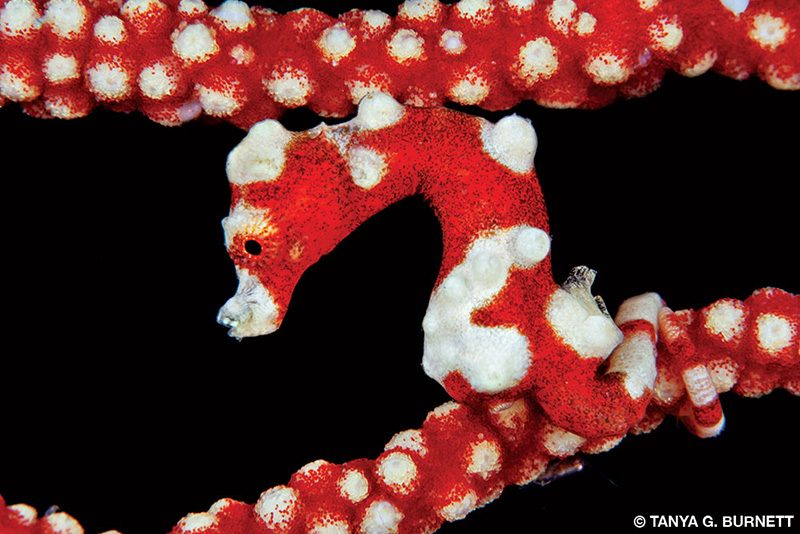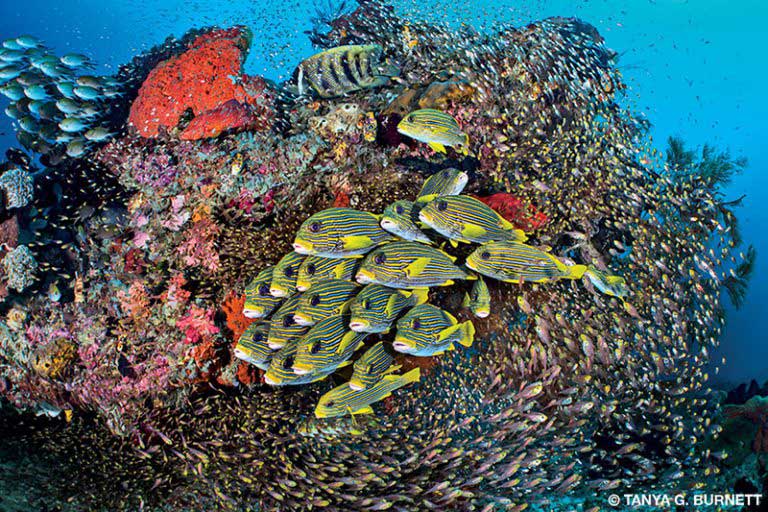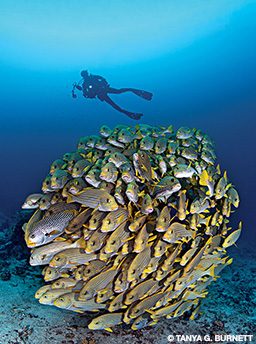Finding magic in Raja Ampat, Indonesia
When asked about my favorite dive destination, I would usually be evasive. “Well, it depends on what I am looking for. There are many locations that are the best in the world for something,” I might respond, which usually was an unsatisfying answer for the inquirer. My response became much easier after my liveaboard trip to experience some of the 15,000 square miles of marine wilderness that is Raja Ampat, Indonesia.
My previous Indonesian dive experience 15 years ago was focused mainly on the abundant central regions, so I was eager to explore the more than 1,500 islands and islets at the eastern edge of the country. My introduction to the area was the no-nonsense commercial hub of Sorong, the main gateway to the Bird’s Head Peninsula of West Papua. Traffic bustled on a bumpy road winding past half-completed construction projects and clapboard shacks on stilts over the water as we approached the harbor. There I made out the distinct profile of the traditional twin-masted, wooden pinisi (or phinisi) schooner — the most popular liveaboard boat style in Indonesia and my home for the next two weeks.
The harbor was a mélange of earthy smells, roosters, skinny dogs and peals of loud bartering at a hectic fish market. The jetty was awash with people laying claim to fresh catch from returning fishermen, while the boat crew tried to negotiate our luggage through the crowds. Sorong was not a pretty port city but rather a gritty introduction to such a vaunted region. Within minutes of leaving the harbor, I watched the vision transform as islands appeared as verdant emerald bubbles on the horizon of endless sea.

The name Raja Ampat means “Four Kings” — a name steeped in myth and legend that refers to the four main islands of Waigeo, Batanta, Salawati and Misool, which are part of the larger collective area known as the Bird’s Head Seascape of West Papua. This diving and tourism frontier spans the equator and is one of the planet’s most biodiverse and rich tropical marine ecosystems, with more than 1,800 tropical fish species and 600 coral species identified — numbers that continue to increase.
With such a large area to dive, many liveaboard trips (and the few land-based operations) focus primarily on a northern or southern itinerary with some overlap in the middle. Conditions can vary considerably in the north and south, and how much area you visit depends on the length of the trip and the best assessment of the captain and crew. It pays to be flexible; do not assume you will be diving the exact itinerary you thought you were booking. The entire area is amazing; what you don’t see on one trip leaves more to be discovered on a future one.

Northern Raja Ampat
Waigeo, the largest island, is located across the Dampier Strait from Sorong and is usually one of the first stops in Raja Ampat. The island has an intricate coastline with caves, bays, gorges, hidden rivers and navigable passes — all buzzing with exotic tropical wildlife, including more than 200 species of birds. The widely varied sites along the southern edge of Waigeo and the neighboring smaller islands are often current-swept and marine-life intensive, offering remarkable opportunities for wide-angle vistas as well as macro critter potential.

On a recent dive on Cape Kri, my dive buddy and I followed the divemaster to a deep ledge to photograph what was easily the biggest school of ribbon sweetlips I had ever seen. For the brief time we were at 120 feet, hundreds of sweetlips transformed from a perfect massive ball to a spinning tornado-like column and continued with other lava-lamp-inspired arrangements. We worked our way back up the slope while heading toward the point as schools of fusiliers, surgeonfish, bigeye trevally and bumphead parrotfish paraded past. At the edge of the reef point, while the current raced just overhead, we hunkered in for a jaw-dropping ballet of life in motion. It was over all too soon as we entered the current and headed for the surface.
Other sites in the region share their own special attractions and may require experienced judgment if large marine life are present when you dive. A good example is the atoll-like site humorously named Ot Di Ma (Where’s My Guide?), where the currents can come in different directions at different speeds. When you hit it right, it is a thrilling drift dive with pulsing swarms of schooling fish, cruising turtles and small blacktip reef sharks skimming over fields of Acropora corals enshrouded with brilliant green and blue damselfish.
Mayhem, another high-voltage dive site, is a submerged reef that rises from 100 feet to almost 20 feet from the surface west of Yanggefo Island. Covered in hard and soft corals and some large boulder coral mounds, the reef is often swarming with glassfish, and a tasselled wobbegong or epaulette shark occasionally hides under a ledge. The highlight is when the current flows onto the northeast corner, creating a mass confluence of schooling jacks, countless fusiliers, surgeonfish, unicornfish and even whole families of lionfish that dance in the current. When I first dived this site I was baffled by a constant droning sound underwater, which our guide indicated was the sound of fish swimming against the current — truly the sound of Mayhem.

Batanta is the smallest of Raja Ampat’s four most populous islands, but this craggy, rugged outpost offers its own special secrets. Located south of Waigeo and separated by the rush of the Dampier Strait, this wild island is ideal for watching many of the unique birds native to the region. You can find several species of birds-of-paradise (including the endemic red and Wilson’s bird-of-paradise) as well as cockatoos, parrots, hornbills, eagles, megapodes, kingfishers and the black palm cockatoo (kakatua raja), among others. One of the most famous and elusive of the local fauna is the Wilson’s bird-of-paradise that can be found only on Waigeo and Batanta. You can try to see this little treasure on Waigeo in the early morning hours after a significant hike to near the treetops where it performs its morning rituals. You might miss a dive or two, but it may well be worth it if you want to see this rare bird.
Hidden beneath the surface of Batanta’s protected waters are some of only a few black-sand muck dive sites in Raja Ampat. On the north side near Pulau Yum, dive sites Yellow Coco and Wruwarez Slope have interesting sloping sand, algae and some coral rubbly bits that create an amazing environment. You can spot cool critters such as frogfish, wonderpus octopuses, tiger shrimp, blue-ringed octopuses, stonefish, bobtail squids, flamboyant cuttlefish, ghost pipefish, juvenile spadefish, many unique nudibranchs, splendid mandarinfish and picturesque dragonets. We spotted a dugong swimming in the shallows off Pulau Birie, and just offshore are reef manta cleaning sites we often had completely to ourselves. It is truly enchanting to have these graceful rays hovering only a few feet away as wrasses swim through the clouds of silversides to clean their winged guests.

Before leaving the northern Raja area, a stop at the islands of Penemu or Wayag is a must. Wayag has some of the most stunning terrain in Raja Ampat; a hike to the top of the island’s Mount Pindito gives a drone’s-eye view of the spectacular surrounds, including jagged peaks, serene protected bays and ocean as far as you can see.
LEARN MORE
The guidebook Diving Indonesia’s Bird’s Head Seascape by Burt Jones and Maurine Shimlock (2011) has been an invaluable resource for many divers. The book is now out of print, but the information is available at birdsheadseascape.com. While Raja Ampat’s unique richness is now well-documented, secrets are still being revealed by those who continue to explore the region.
Southern Raja Ampat
Misool, also known as Batanme, is the second-largest island in the archipelago. A shallow shelf extends from its southeast area, which is surrounded by enormous limestone rocks that emerge from the water to dominate the horizon. Among this terrestrial sculpture, a thick forest of mixed palms, exotic orchids and a swamp full of vegetation differs widely from the classic tropical image of white-sand beaches and coconut palms. Discoveries made here over the years include huge caves, ancient rock-art paintings and petroglyphs dating back 3,000 to 5,000 years. At least three closed ponds contain hundreds of stingless giant golden medusa jellyfish.

Some of Misool’s signature dive sites include Boo Windows, Tank Rock, Whale Rock and Nudi Rock, which start just below the surface where even snorkelers can see gardens of multihued soft corals swaying gently in the shallow currents. From there, shelves of table corals terrace down to deeper ledges where huge branching gorgonian fans of many hues filter nutrients from the water. The kaleidoscopic vistas are sometimes so wide and inspiring that trying to capture the full scene with a camera simply does not do it justice. For those who love macro subjects, all manner of critters thrive here, including several species of pygmy seahorses. Rare nudibranchs, saron shrimp, wire coral crabs, frogfish and one of the most stunning endemic flasher wrasses to ever court a female can persuade the enthusiast to dive into the dusk hours and beyond. These sites are part of the Misool Private Marine Reserve, which has a 460-square-mile no-take zone (NTZ).
At the easternmost edge of the Misool NTZ is Pulau Daram, a series of islands grouped tightly together and one of the least-explored areas in the region. Daram, as most people refer to the area, is remote with minimal anchorage areas and some of the most pristine sites in Raja Ampat. One favorite is Andiamo, where you will find a small submerged pinnacle awash in golden confetti of refracted sunlight. A vertical window through the rock island is festooned with bright orange soft corals and populated with scores of regal demoiselle. Schools of golden sweepers frequent the opening, pulsing in unison to discourage the numerous predators lying in wait. We followed the deep ridge to the main rock formations and then slowly ascended through the thick layers of branching corals and colorful sea fans to be greeted by the delicate finning of a resident group of batfish forming precision vertical schools in the blue. Other top-notch sites in Daram include Andy’s Ultimate and Candy Store.
The greater Misool region has rapidly become famous for a menu of other remarkable dive sites that include classics such as No Contest, Love Potion No. 9, Four Kings and Kaleidoscope. But one site holds near-mythical status among visiting divers: Magic Mountain. It never provides the same dive twice and rarely disappoints. Access to the site is regulated, so dives must be prescheduled by radio to ensure only one dive boat at a time is on the site.

We received the exciting news that we were approved for a morning descent on Magic Mountain. Our dive guides returned from checking currents on the site, and their Cheshire cat grins left little doubt about what was in store. They had spotted manta rays, particularly the giant oceanic manta (mobula birostris), on the surface just above the plateau. Our guides briefed us again about cleaning station awareness and etiquette to ensure the best experience for both divers and mantas. Our group split into two drop locations on the pinnacle: one on top of the reef and the other toward a ridge extending out to deeper cleaning station.
My group, which was on the ridge drop, back-rolled into a rapid descent with our eyes peeled for the distinctive black and white markings and triangular wings of these big rays. The dive site is massive, and we could not see the other group from our location. Through the sun-dappled blue, however, we saw the unmistakable grace of a giant manta on a circular glide path, punctuated by a near-motionless hover as dozens of bright wrasses appear to pick unwelcome parasites from the manta’s skin. This dance-like ritual has occurred for countless eons, but only in the past few decades have we been able to glimpse this hypnotic relationship.

This cleaning station is magical enough, but the depth means a short dive. After reluctantly parting from our beautiful encounter, we made our way back up the ridge to the shallower reefs, which are lively with huge schools of batfish, patrolling gray reef sharks, tight groups of barracudas, comical Napoleon wrasses, swarms of undulating snappers, endless fusiliers, the passing squeaks of bottlenose dolphins and more mantas getting cleaned. The same willing little reef fish groom both oceanic mantas and the smaller reef mantas. Magic Mountain once again lived up to its name, and we wondered how soon we could dive there again.
Now when someone asks me about my favorite dive location, my mind unfurls images of interconnected rock islands along with early morning mist rising from the calm waters of protected anchorages, accented by the cry of a black palm cockatoo greeting the day. I envision steep karst peaks plummeting into current-swept seas over an explosion of colorful reefs with exotic fish swarming in waves over meticulously arranged table and lettuce corals, while the passing shadow of a giant winged siren glides silently overhead.
How to Dive It
Getting there: Many airlines fly to the international gateways within Indonesia. Popular airport hubs with direct flights to Sorong (SOQ) are Jakarta, Java (CGK), and Manado, Sulawesi (MDO). You can also fly to Denpasar, Bali (DPS), but most domestic flights from Bali to Sorong require a stop in Makassar, South Sulawesi, formerly known as Ujung Padang (UPG). There are numerous domestic Indonesian carriers such as Garuda Indonesia, which in addition to checked bags allow you to bring up to 50 pounds of scuba gear on their flights without charge. Consider arriving at an international hub one day prior to checking into a domestic flight and on your return in case your luggage needs to catch up with you.

Indonesia information: Most visitors are granted a 30-day tourist visa at no charge. The official currency is the Indonesian rupiah (IDR), and currency exchange is easily available through ATMs and banks in the main gateways. Have some IDR in hand when visiting the remote regions. Most places accept Visa and Mastercard, but a 3.5 percent fee may be added to your bill.
Dive permit: The Raja Ampat Marine Park entry permit is 1 million IDR (about $70 to $100, depending on the exchange rate) and is good for one year. Most liveaboard and land-based dive operations arrange this permit for you.
Dive conditions: Prime diving season is October to April, though visibility can be influenced by high plankton concentrations, which ensure more pelagic encounters. Visibility is best from May to August. The rainy season from June to September can bring high winds, and some resorts, especially in the south, will close due to rough conditions. Water temperatures typically range from 82°F to 86°F but can dip to 79°F in some areas. Plan to dive in at least a 3 mm full suit, and bring a hood, hooded vest or other type of thermal layering for added warmth.
Explore More
See more of Raja Ampat in this video by Burt Jones and Maurine Shimlock.
© Alert Diver — Q2 2019